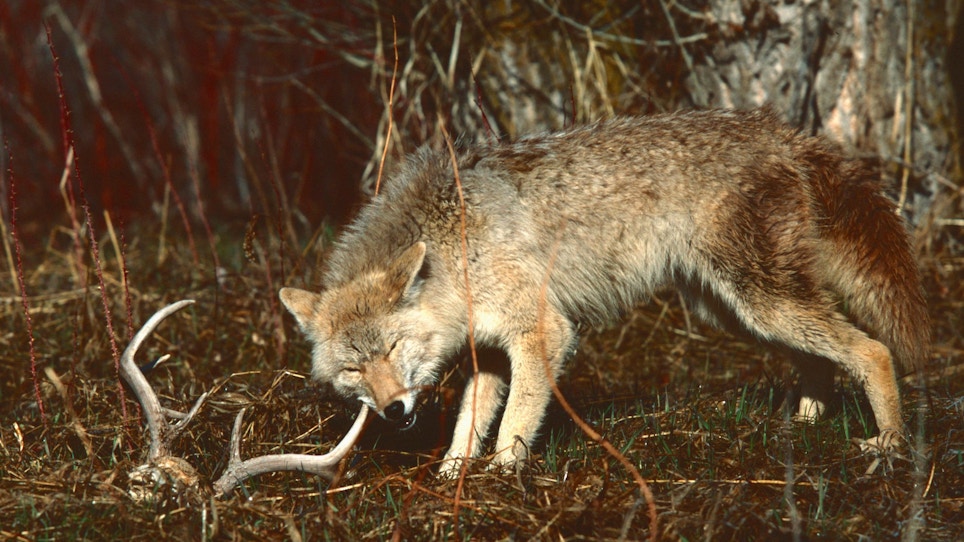
Coyotes eat a wide variety of foods based on the season and whatever is available. Spring and summer are flush with rabbits, varmints, fawns and other things, but it's not a surprise when they find something different such as a deer antler. (Photo: Mark Kayser)
It’s about to get very, very busy in the kitchen area of coyote dens across the country with pups either cozy in the den or on the way. Knowing what a coyote eats helps predator hunters and animal control officers alike in their mission to understand, or target a marauding family group.
You’ve heard coyotes titled as opportunists that will eat almost anything. It’s true, but environmental factors and seasonality change diet intake. A 4-year research project completed by the Virginia Department of Game & Inland Fisheries was launched to gather information on whether coyotes were in fact responsible for whitetail deer declines. Researchers at Virginia Tech took on the study in 2011 in the mountains of western Virginia where deer numbers were declining. Their goal was to discover coyote diet throughout the year along with movement behavior. A side bonus was to gather information on bobcat and bear diets in the same region.
“To study the diet of coyotes, researchers meticulously examined 395 coyote scats (feces samples) collected monthly over a 2-year period. They found out that coyotes eat deer very frequently. White-tailed deer had the highest overall occurrence in the scat (74 percent), followed by voles (27 percent) and insects (16 percent). Seasonally, deer occurrence in the scats was greatest in January, March, June, July and November. The June-July period coincides with the fawning season but deer were also an important food item during the early fall and late-winter months.”
Other research corroborates that fawns become a target food source in the spring with some coyotes relying on fawns for 70 percent or more of their diet. The same is true of fall and winter where coyotes take advantage of gut piles left by hunters and winterkills later. The study continues with a breakdown of the diet discovery from bobcats and black bears in the region.
“Coyotes were not the only predators eating deer in the study areas. Of the 607 bobcat scats analyzed, deer were found in 35 percent and squirrels were found in 53 percent. Seasonally, deer was highest in the scats during June (when most fawns are born) and in late winter (December and January). Bears also had a high occurrence of deer in their scat (35 percent), but acorns and berries were found in 61 percent and insects were found in 45 percent.”
One of the longest running coyote research projects is located within Chicago and referred to as the Urban Coyote Research Project. They’ve been into poop analysis too (scat examination) with one study reviewing 1,429 piles.
What did they discover?
“Dominant food items included small rodents, white-tailed deer (Odocoileus virginianus), fruit, eastern cottontail (Sylvilagus floridanus) and birds. Their availability and occurrence in scats varied among sites and seasons. The occurrence of human-associated food items, which was only found in significant amounts in the most developed site, varied seasonally (2 to 25 percent).”
In short, pets and garbage weren’t topping the list as many folks suspect living in metro areas. Of course that’s not to say Fluffy didn’t become an hors d'oeuvres on a nightly bathroom romp.
One food aisle raiding mission that humans may not tie to coyotes is the fruit and vegetable garden later in the summer. Remember that coyotes can swap nutritional needs faster than a diet-fad-following celebrity. During the late summer and into early fall coyotes habitually switch from an all meat diet to more of an omnivore lifestyle. Gardens are a favorite raiding location. Fruits, berries and vegetables are all on the menu with a consistent liking for melons.
I was reminded of that while talking to retiredstate animal damage control officer Steve Thompson. He worked for the South Dakota Department of Game, Fish and Parks for 15 years. Today Thompson designs and manufactures predator calls along with custom lanyards in his home-based company called Dakota Coyote Howler, but he recalled several times he was called to help with garden-looting coyotes. Most had a partiality to melons so keep that in mind as the days grow longer.
Can coyotes have an impact on specific species as they eke out a living? Sure, but it varies day by day and with a hungry bunch of pups about to enter the dining hall anything is one the table.





